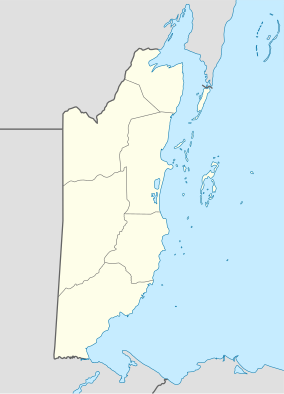| Bladen Nature Reserve | |
|---|---|
 Central River at sunrise | |
| Location | Toledo, Belize |
| Coordinates | 16°29′28″N 88°53′10″W / 16.491°N 88.886°W[1] |
| Area | 99,796 acres (40,386 ha) |
| yaaxche.org | |
Bladen Nature Reserve in Belize is a landscape of caves, sinkholes, streams and rivers, old growth rainforest and an abundance of highly diverse flora and fauna which includes a great deal of rare and endemic species.
Widely described as the crown jewel of Belize's protected areas, Bladen is considered to be one of the most biodiversity-rich, and geographically unique areas within the Mesoamerican Biological Corridor.[citation needed] At 99,796 acres (40,386 ha) Bladen forms a significant portion of the Key Biodiversity Area[2] of the Maya Mountains which was identified as one of the most important blocks of protected areas within Belize and more broadly, Mesoamerica, itself a region considered a world ‘hotspot for species diversity’[3] and considered critical for the preservation of the biodiversity of the Western Hemisphere.
At its most sheltered points, west of the rugged karst (limestone) hills, Bladen has protection from many of the destructive storms that hit the Caribbean coastline, resulting in a forest with a little-disturbed structure, tall trees of impressive stature and intact ecosystems. The large number of ecosystems encompassed within the nature reserve highlights its importance as a strictly protected conservation area. Bladen protects species diversity across a great range of elevations, which according to recent evidence includes several potential new and endemic species.[4]
Within the Maya Mountains, Bladen forms a crucial link between Cockscomb Basin Wildlife Sanctuary to the northeast and Columbia River Forest Reserve to the southwest. Chiquibul National Park and Forest Reserve lie to the northwest, connecting to the protected areas system in Guatemala. With the rapid clearance of forested areas throughout Central America, this is part of the last remaining large, relatively intact block of forest within the region – the Selva Maya - stretching from Belize through to Guatemala and Mexico.
This large expanse of primarily forested uplands and valleys is essential for the survival of species such as the jaguar, scarlet macaw, white-lipped peccary and harpy eagle, which need large contiguous forest stretches in order to maintain viable populations.
- ^ "Bladen Nature Reserve". protectedplanet.net.
- ^ Meerman J. (2007). Establishing a Baseline to Monitor Species and Key Biodiversity Areas in Belize. Critical Ecosystems Partnership Fund
- ^ Conservation International (2003) Biodiversity Hotspots - Mesoamerica. www.biodiversityhotspots.org
- ^ Nicholas Wicks N., Pizii B., Walker P., Matamoros W., Medina M., Miller N., Bonilla V., Rapid Ecological Assessment of Central River (2010) Ya'axche Conservation Trust

